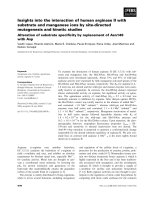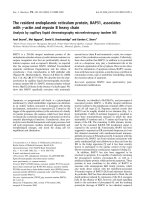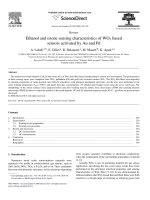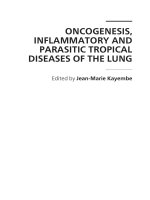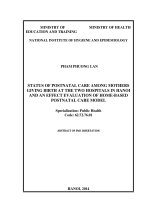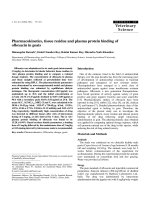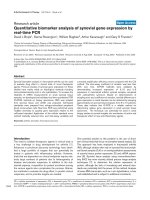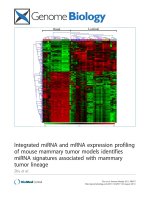Fast, selective and quantitative protein profiling of adenovirus-vector based vaccines by ultra-performance liquid chromatography
Bạn đang xem bản rút gọn của tài liệu. Xem và tải ngay bản đầy đủ của tài liệu tại đây (1.85 MB, 8 trang )
Journal of Chromatography A, 1581–1582 (2018) 25–32
Contents lists available at ScienceDirect
Journal of Chromatography A
journal homepage: www.elsevier.com/locate/chroma
Fast, selective and quantitative protein profiling of adenovirus-vector
based vaccines by ultra-performance liquid chromatography
Ewoud van Tricht a,∗ , Pascal de Raadt a , Annemiek Verwilligen a , Martijn Schenning a ,
Harold Backus a , Marta Germano a , Govert W. Somsen b , Cari E. Sänger-van de Griend c,d
a
Janssen Vaccines and Prevention, Pharmaceutical and Analytical Development, Newtonweg 1, 2333 CP Leiden, The Netherlands
Vrije Universiteit Amsterdam, Divison of BioMolecular Analysis, Amsterdam Institute of Molecules, Medicines and Systems, De Boelelaan 1083, 1081 HV
Amsterdam, The Netherlands
c
Kantisto BV, Callenburglaan 22, 3742 MV Baarn, The Netherlands
d
Uppsala University, Faculty of Pharmacy, Department of Medicinal Chemistry, Biomedical Centre PO Box 574, SE-751 23 Uppsala, Sweden
b
a r t i c l e
i n f o
Article history:
Received 25 June 2018
Received in revised form 19 October 2018
Accepted 22 October 2018
Available online 26 October 2018
Keywords:
Intact proteins
Adenovirus
Protein profiling
RP-UPLC
Quantification
a b s t r a c t
A method for the quantitative determination of the protein composition of adenovirus-vector based
vaccines was developed. The final method used RP-UPLC with UV absorbance detection, a C4 column
(300 Å, 1.7 m, 2.1 × 150 mm), and a water- acetonitrile (ACN) gradient containing trifluoroacetic acid
(TFA) as ion-pairing agent. The chromatographic resolution between the various adenovirus proteins was
optimized by studying the effect of the TFA concentration and the column temperature, applying a full
factorial design of experiments. A reproducible baseline separation of all relevant adenovirus proteins
could be achieved within 17 min run time. Samples containing adenovirus particles could be directly
injected into the UPLC system without sample pretreatment. The viruses reproducibly dissociate into
proteins in the UPLC system upon contact with the mobile phase containing ACN. The new RP-UPLC
method was successfully validated for protein profiling and relative quantification of proteins in vaccine
products based on adenovirus vector types 26 and 35. The intermediate precision of the relative peak
areas of all proteins was between 1% and 14% RSD, except for the peak assigned to protein V (26% RSD). The
method proved to be stability indicating with respect to thermal and oxidation stress of the adenovirusvector based vaccine and was successfully implemented for the characterization of adenovirus-based
products.
© 2018 Elsevier B.V. All rights reserved.
1. Introduction
Adenoviruses are non-enveloped icosahedral-shaped viruses
of 70–90 nm, consisting of a protein capsid containing a double
stranded DNA genome [1,2]. Adenoviruses are promising vectors
®
for intracellular delivery of DNA [3]. The Advac technology in
®
combination with the PER.C6 technology [4,5] allows for the
production of adenovirus vectors in which the viral DNA can be
modified to encode for an antigen of interest. For example, in
the case of the Ebola vaccine the adenovirus vector is modified
to encode for a certain glycoprotein from the Ebola virus [6].
Upon vaccination, this glycoprotein is expressed in the host cell
and presented to the immune system, thereby expectedly eliciting a protective immune response against the Ebola virus. The
∗ Corresponding author.
E-mail address: (E. van Tricht).
/>0021-9673/© 2018 Elsevier B.V. All rights reserved.
adenovirus proteome is composed of different proteins in varying stoichiometries [1,7]. The adenovirus proteins are identified by
numbers, in order of decreasing molecular weight as observed by
SDSPAGE [8]. The virus capsid consists of 240 trimers of protein II
(hexon) and 60 copies of protein III (penton base). The fiber protein
(IV) is extending outwards from the penton bases and is considered essential in the binding of the adenovirus to the cell surface.
Four minor proteins (IIIa, VI, VIII and IX) are located on the inner
side of the capsid and are thought to act as cement proteins. The
core of the particle contains six different proteins: V, VII, X, IVa2,
the terminal protein (TP), and the adenovirus protease (AVP) [1].
The viral protein identity, heterogeneity and content in the adenovirus particles determine the identity of the particle, its interaction
with the cell and, possibly, its stability. If the incorrect proteins
are expressed or the virus particles are not correctly assembled,
then this could lead to adenoviruses with decreased or no biological activity, and, therefore, a vaccine with decreased potency. In
addition, degraded or modified proteins in the adenovirus vector
26
E. van Tricht et al. / J. Chromatogr. A 1581–1582 (2018) 25–32
Fig. 1. RP-HPLC-UV chromatogram of an adenovirus vector type 26 sample. Method based on Lehmberg et al. [26] and Liu et al. [10]. Column, Vydac 214TP C4 300 Å 5 m,
2.1 × 250 mm. Solvent A, 5% ACN in milli-Q with 0.1% TFA; solvent B, 0.1% TFA in 99% ACN. Linear gradient with 3 slopes, 20%–34% solvent B at 37 min, 34%–46% solvent B at
85 min, 46%–60% solvent B at 110 min. Injection volume, 100 l; flow rate, 0.2 ml/min; column temperature, 40 ◦ C; sample tray temperature, 8 ◦ C; UV absorbance detection
at 280 nm.
particles could also result in decreased biological activity or adverse
effects upon vaccine administration. It is a challenge to develop a
suitable analytical method for the analysis of the adenovirus proteins due to the great dynamic range needed to measure all protein
subunit concentrations simultaneously, and due to the large variability of protein sizes and charges [9]. The molecular masses of the
adenovirus proteins range between 7 and 108 kDa, and the copy
numbers per virus particle are between 2 (for the TP) and 720 (for
the protein II monomer) [1,10,11]. An additional layer of complexity is added by the need to disassemble the adenovirus into stable
and analyzable protein before analysis. Typically, an extensive sample treatment is required to denature the viruses into proteins, to
remove matrix components (e.g. surfactants) from the samples, or
to concentrate the samples [12,13]. Intact proteins in biopharmaceutical products are commonly analyzed by spectrometry [14],
electrophoresis [15], liquid chromatography [16,17], or mass spectrometry [14,18–20]. More specifically, viral proteins are typically
analyzed by SDS-PAGE [10,21,22], capillary gel electrophoresis
(CGE) [23–25] or RP-HPLC [12,13,26]. SDS-PAGE has been extensively used for adenovirus protein analysis [27,28]. The key proteins
of the adenovirus are separated from each other by SDS-PAGE,
and MS can be used after in-gel trypsin digestion for band assignment. Such methods do not allow for accurate quantification of
the adenovirus proteins due to the poor separation on the gel. In
addition, protein modifications (for example, detected by MS) could
be introduced by the harsh SDS-PAGE and MS pretreatment conditions. Capillary gel electrophoresis was applied for the analysis
of recombinant GB virus-C proteins [29], the analysis of the four
major influenza virus proteins [25], and the characterization of proteins from Western, Eastern, and Venezuelan equine encephalitis
(WEVEE) virus like particles (VLPs) [23]. The downside of the capillary gel electrophoresis methods is the limited molecular weight
range. The method has a low efficiency for proteins with sizes lower
than 15 kDa or larger than 100 kDa resulting in insufficient resolution. Another drawback is the extensive sample treatment that is
required to denature, reduce and alkylate the virus samples before
analysis by CGE. Liquid chromatography-based methods for analysis of intact proteins in virus and virus-based vaccines have been
reported in the literature. Although RP-LC is already an established
technique for protein analysis, recent technology developments
especially improved the stationary phases (i.e. particle sizes down
to 1.7 m with pore sizes of 300 Å) allowing for even better, more
reproducible separation of intact proteins [14]. Another technical
improvement is the introduction of low-binding materials in the LC
equipment that decreased artifacts such as adsorption to injectors,
tubing etc. [14]. RP-HPLC was used for analysis of the nucleocapsid protein (N-protein) from the severe acute respiratory syndrome
(SARS) coronavirus [13]. Separation was on a reversed phase C18
column (5 m particle size and 300 Å pore size) with ACN/water
and trifluoroacetic acid (TFA) as mobile phase. Prior to analysis, the
samples were dialyzed, lyophilized, and concentrated. The method
did not achieve baseline resolution between the analyte of interest and interfering peaks from the sample matrix. The N-protein
could only be identified after fraction collection and MALDI-TOF
analysis. RP-HPLC [12,30,31] was also used for quantification of the
influenza hemagglutinin protein (HA) from the influenza virus. HA
is cleaved by trypsin into a hydrophilic HA1 and a hydrophobic
HA2 fragment. With RP-HPLC, fragment HA1 is well-resolved from
other sample components and a quantitative method with external calibration has been reported in the literature [31]. The sample
preparation in this method is laborious and time-consuming and
the other major proteins from the influenza virus, HA2, M and NP,
could not be detected. An RP-HPLC with UV absorbance detection,
based on Lehmberg et al. [26] and Liu et al. [10], is being used for
quality control of the protein profile of adenovirus vaccine products, see Fig. 1 for an example chromatogram. Disadvantages of
the RP-HPLC method are its inadequate resolution for certain proteins (e.g. protein II and IX) and the insufficient repeatability of the
retention times and peak areas. Therefore, reliable quantification
of all proteins by RP-HPLC is not possible. Another drawback of the
RP-HPLC method is its very long run time of 130 min, which limits the throughput to 10 samples per sequence (including controls
and blanks) as sample instability is observed after sample storage
for 18 h in the auto sampler. This paper describes the development and validation of an RP-UPLC method for protein profiling
of adenovirus serotype 26 (Ad26) and 35 (Ad35) in adenovirus
vector-based vaccine products. The method has two purposes: confirm identity of the test sample and detect protein modifications or
degradation products of the adenovirus vector. For identity purposes, the protein profile of the test sample is compared to the
profile of a reference sample based on the relative retention times
and relative peak areas. By calculating the relative peak areas of all
peaks in the chromatogram and identifying new peaks in the chromatogram, the method also allows the detections of degradation
products in the sample Additional requirements for the method
development were: a chromatographic run time of less than 30 min,
baseline separation of all relevant adenovirus proteins allowing for
their quantification, and an increased method robustness.
E. van Tricht et al. / J. Chromatogr. A 1581–1582 (2018) 25–32
2. Materials and methods
2.1. Chemicals
Acetonitrile UPLC/MS grade (PN 01204101) from Biosolve
(Valkenswaard, the Netherlands), Acetonitrile gradient grade
(SN 34851-2.5L), Trifluoroacetic acid 99+% (PN 302031) and
cytochrome-C (PN C2506) from Sigma-Aldrich (Zwijndrecht, the
Netherlands), methanol (PN 106008) and Milli-Q water from Merck
Millipore (Amsterdam-Zuidoost, The Netherlands). Formulation
buffer, Ad35 reference material (with transgenes B and C), Ad26
reference material (with transgenes A and B) and Ad26 process
samples were from Janssen Vaccines (Leiden, the Netherlands).
Ammonium bicarbonate (PN 40847) from Honeywell (Bucharest,
Romania), Trypsin (PN V5111) from Promega (Madison, WI, USA),
formic acid (PN 06914143) and water UPLC/MS grade (PN 23214B1)
from Biosolve (Valkenswaard, the Netherlands), Q-Tof Qualification Standards Kit (PN 700003276) and leucine encephalin (PN
186006013) from Waters Corp. (Milford, MA, USA).
2.2. Liquid chromatography
A Waters Acquity H-class UPLC system equipped with a quaternary solvent manager, autosampler, and PDA detector (Waters
Corp., MA, USA) was used. Data processing was performed by
Empower 3 software. Various settings were tested in method
development; the settings for the final, validated method were as
follows. The analytical column was an Acquity UPLC Protein BEH
C4 Column (300 Å, 1.7 m, 2.1 × 150 mm). New analytical columns
were preconditioned with 3 injections (30 l each) of 10 mg/ml
cytochrome-C followed by 3 injections (30 l) of Milli-Q water to
prevent unwanted protein adsorption with the stationary phase.
Solvent A was 5% v/v acetonitrile (ACN) in Milli-Q water, solvent
B was 100% ACN, and solvent C was 1% w/v TFA in 5% ACN. From
A, B and C a linear elution gradient was formed from 20% ACN to
60% ACN containing 0.175% w/v TFA in 17 min. The flow rate was
0.6 ml/min, the injection volume was 30 l, the column temperature was 50 ◦ C, the auto sampler temperature was 8 ◦ C, and for
detection UV-absorbance was monitored at 280 nm. After analyses, the system was flushed with 30% v/v ACN in Milli-Q, the needle
wash was with 20% v/v ACN in Milli-Q, and pump seal wash was
with 10% v/v methanol in Milli-Q.
2.3. MS-based protein peak assignment
For preparative runs intended for peak assignment, samples
of selected AdVac vaccines were first concentrated in 1.5 ml
Eppendorf® LoBind microcentrifuge tubes Protein (Hamburg,
Germany) by centrifugation in an Eppendorf 5417R microcentrifuge at 17000 g for 30 min at 4 ◦ C and removal of the supernatant.
Concentrated samples were analyzed by the RP-UPLC method on
a Waters Acquity H-class UPLC system (method as described in
Section 2.2). Fractions were collected every 10 s for 16 min in
Eppendorf twin.tec PCR Plates LoBind using the fraction collector
of a TriVersa NanoMate® (Advion, Ithaca, NY, USA). The fractions
were dried in a vacuum centrifuge without heating for 4 h. The pellets were resuspended in 6 l of 30% ACN, then 12 l of trypsin
solution (20 g/ml in 50 mM Ammonium bicarbonate) was added,
and samples were incubated overnight at 37 ◦ C. The tryptic digests
were again dried in a vacuum centrifuge and resuspended in 18 l
of 20% ACN with 0.1% formic acid. The trypsin digests were analyzed by LC–MSE on a Waters Acquity H-class UPLC system coupled
to a Waters Synapt G2-SI mass spectrometer (Waters Corp., MA,
USA). The analytical column was an Acquity UPLC Protein BEH C18
Column (300 Å, 1.7 m, 2.1 × 150 mm). Solvent A was 0.1% formic
acid in Milli-Q water and solvent B was 0.1% formic acid in 100%
27
ACN. Elution was by a linear gradient from 2% B to 35% B in 45 min.
The flow rate was 0.2 ml/min, the injection volume was 10 l, the
column temperature was 40 ◦ C, the autosampler temperature was
6 ◦ C. For MSE conditions were: collision energy, 20 40 V (ramped);
lock-mass solution, leucine enkephalin (2 ng/ml) in 1:1 ACN-MilliQ water with 0.1% formic acid; lock-mass flow, 5 l/min; capillary
voltage, 3.0 kV, sample cone temperature, 25 ◦ C; source temperature, 120 ◦ C; desolvation gas, 800 L/h; cone gas flow rate, 20 L/h;
employing resolution mode with 1 scan per s.
2.4. Preparation of stressed samples
Samples of adenovirus vector type 26 based vaccine were first
diluted to 2.0 × 1011 virus particles (vp)/ml in formulation buffer
and then the following stress conditions were applied: thermal
stress by incubation at 50 ◦ C for 45 or 120 min; oxidative stress by
addition of 30% v/v hydrogen peroxide and incubating for 4 h. The
stressed samples were analyzed by capillary zone electrophoresis
(CZE) according to Van Tricht et al. [32], by potency assay according
to Ma et al. [33], and by RP-UPLC as described above (Section 2.2.).
To compare the different techniques recoveries between stressed
samples and non-stressed samples were used (i.e. total peak area
recovery for RP-UPLC, potency recovery for the potency assay or
virus particle concentration recovery for CZE).
2.5. Method validation
Specificity was demonstrated during development for Ad26 and
Ad35 proteins by MS-based peak assignments and by demonstrating absence of the viral proteins in the formulation buffer. The
method repeatability, accuracy, intermediate precision, and linearity were determined for 5 concentration levels in the range of
0.5 × 1011 – 2.0 × 1011 vp/ml with 3 replicates at each concentration level, repeated on 3 different days by two operators on two
analytical columns, and two LC instruments. The method repeatability requirements were ≤ 15% RSD for relative peak areas and ≤
1% RSD for relative retention times. The intermediate precision was
determined based on the method repeatability and linearity data
on three different days and the limits were ≤20% RSD for relative
peak areas and ≤ 2.0% RSD for relative retention times. The linearity
requirements were r2 ≥ 0.98 and the sum of residuals less than 5%.
The accuracy requirement was recoveries of 80–120% for relative
peak areas. The limit of quantification (LOQ) was determined as the
lowest concentration level that met the requirements for accuracy
and precision. Robustness was derived from the results of method
development obtained with design of experiments.
3. Results and discussion
3.1. Translation from HPLC to UPLC and determination of critical
method parameters
In the original RP-HPLC method, based on Lehmberg et al. [26]
and Liu et al. [10], the adenovirus proteins were separated on a
C4 column (5 m, 2.1 × 250 mm) with a water-ACN gradient, with
three segments of different slopes, from 20% to 60% ACN containing
0.1% TFA in 110 min, see Fig. 1. The adenovirus samples are directly
injected into the UPLC system without sample pre-treatment (e.g.
denaturation, reduction or dilution) and the viruses dissociate into
proteins upon coming in contact with the water-ACN mobile phase
in the UPLC system. Dissociating the viruses into proteins prior to
the UPLC analysis resulted in irreproducible chromatograms (data
not shown) [26]. This method was transferred to an UPLC Xbridge
BEH 300 C4 column (1.7 m, 2.1 × 150 mm). The linear gradient
with three slopes was replaced by a single-slope linear gradient
to improve elution reproducibility and the flow rate was increased
28
E. van Tricht et al. / J. Chromatogr. A 1581–1582 (2018) 25–32
Fig. 2. RP-UPLC-UV of Ad26 sample measured with different TFA concentrations using a column temperature of 50 ◦ C (A–F) and Ad26 sample measured with different column
temperatures with 0.1% TFA (G–J). TFA concentration in solvent B: 0.09% (A), 0.10% (B and G – J), 0.12% (C), or 0.15% (D), 0.175% (E), or 0.20% (F) TFA. Column temperature:
45 ◦ C (G), 50 ◦ C (H and A – F), 60 ◦ C (I), or 70 ◦ C (J). The Ad26 sample was diluted in formulation buffer to a concentration of 2.5 × 1011 vp/ml. Column, Xbridge BEH 300, C4,
300 Å, 1.7 m, 2.1 mm x 150 mm. Solvent A, 5% ACN in Milli-Q water; solvent B, variable amounts of TFA (see above) in 99% ACN; gradient, 20%–50% solvent B in 17 min.
Injection volume, 30 l; flow rate, 0.6 ml/min; sample tray temperature, 8 ◦ C; UV absorbance detection at 280 nm.
from 0.2 to 0.6 ml/min, thereby decreasing the separation time from
110 min to 22 min.
The critical method parameters of the RP-UPLC method were
studied in a screening design of experiments to assess their impact
on the method’s run time and the resolution between the adenovirus proteins.: The following conditions were evaluated: gradient
start composition (0–20% solvent B), gradient end composition
(45–65% solvent B), gradient run time (17–25 min), TFA concentration (0.04–0.12%), and column temperature (40–70 ◦ C). JMP
statistical software was used to fit a model based on standard least
squares using the main effects of the parameters. The response that
was chosen to study the effect of the tested parameters was the best
resolution between the maximum number of protein peaks with
the shortest run time. From a Pareto-analysis with standardized
parameter estimates it was concluded that the TFA concentration and the column temperature had the strongest impact on the
response. The peaks between approximately 6 and 8 min (proteins
V, VII and VIII) and between 13 and 15 min (proteins IIIa and IX)
were most influenced by the column temperature and the TFA concentration (Fig. 2A–C and G–J). The best resolution between the
different peaks was obtained at the highest concentration of TFA
(0.12%) and a column temperature of 50 ◦ C (Fig. 2B). The gradient
start and end composition and the gradient time were not critical
regarding resolution or elution order, provided the gradient start
composition was above 10% ACN to assure complete dissociation
of the virus particles and the end composition was above 45% ACN
to allow elution of all adenovirus proteins. Based on this feasibility
experiment, the gradient start composition was fixed at 20% B and
the end composition at 50% B, with a gradient time of 17 min. These
settings resulted in the shortest run time with the best resolution
possible. Initially, solvents A and B were prepared with 0.04–0.12%
TFA, however, allowing this range of TFA concentration caused dayto-day variability (i.e. shifts in retention time), indicating that the
TFA concentration is a critical method parameter which needs to
be tightly controlled. Fig. 2A–C shows that TFA has a significant
effect on the separation even with slight changes from 0.09% to
0.12% TFA. The method robustness with respect to this parameter
was examined specifically by design of experiments (see below,
Section 3.1.1). In addition, to increase the reproducibility of the
mobile phase composition, the gradient mobile phase preparation
method was changed as follows: Solvent A was 5% ACN in water,
solvent B was 100% ACN, and solvent C was 1% TFA in 5% ACN. The
UPLC-system was then used to mix the three solvents to reproducibly obtain constant concentrations of TFA in the mobile phase
throughout the gradient.
3.1.1. Design of experiments – optimization of TFA concentration
and column temperature
The effects of the TFA concentration in the mobile phase and the
column temperature were studied by a 31 41 full-factorial design (1
factor at 3 levels and 1 factor at 4 levels) with the aims to reduce
the total run time of the analytical method and to improve the separation of critical peak pairs: V-VIII(1), VIII(1)-VII, VII-VI(2) (Ad35
only), VI(2)-VI(3) (Ad26 only), II-IX, and IX-IIIa. The selected factors
were: TFA concentration, 0.150, 0.175, or 0.200%; column temperature, 40, 50, 60, or 70 ◦ C. The study was executed by analyzing
both Ad26 and Ad35 samples. The responses that were considered to evaluate the effects were the retention time of protein II
(used as indicator of the method’s run time) and the separation
of the critical peak pairs (see above). As the protein peak widths
did not significantly change under the tested conditions, the differences in retention times of the critical peak pairs were used instead
of the resolution as indicator for separation. A protein retention
difference of 0.3 min or higher corresponded with baseline separation. The data were processed by JMP statistical software based on
the factor main effects and interaction effects. For both adenovirus
type 35 (Fig. 3A) and type 26 (Figs. 2E and 3 B) critical peak pairs
were baseline separated in 17 min using 0.175% TFA and a column
temperature of 50 ◦ C. The contour plot in Fig. 4 summarizes the
results of this design of experiments. Peak pairs II-IX and VVIII(1)
were baseline separated at all tested conditions, with a retention
time difference of > 0.6 min (Fig. 2D–F). For column temperatures
between 40 and 55 ◦ C, the separation of peak pair VI(2)VI(3) (Ad26
only) was compromised (resolution 0.8) at a TFA concentration of
0.2% (Fig. 2F), but remained acceptable (baseline resolution) for the
other peak pairs. Column temperatures of 55 ◦ C or higher resulted
in insufficient separation for three out of five peak pairs at all TFA
The robustness of the method for small changes in the TFA concentration was studied by assessing the reproducibility of the retention
times and peak areas. An Ad26 sample was analyzed at four dif-
E. van Tricht et al. / J. Chromatogr. A 1581–1582 (2018) 25–32
29
Fig. 3. RP-UPLC-UV of A) adenovirus vector type 35 samples and B) adenovirus vector type 26 samples at optimum separation conditions. AI) Adenovirus vector type 35
with transgene C, AII) Adenovirus vector type 35 with transgene B. BI) Adenovirus vector type 26 with transgene A, BII) Adenovirus vector type 26 with transgene B. Column,
Xbridge BEH 300, C4, 300 Å, 1.7 m, 2.1 mm x 150 mm. Solvent A, 5% ACN in Milli-Q water; solvent B, ACN; solvent C, 1% TFA in 5% ACN; gradient, 20%–50% ACN in 17 min with
TFA concentration of 0.175%. Injection volume, 30 l; flow rate, 0.6 ml/min; column temperature, 50 ◦ C; sample tray temperature, 8 ◦ C; UV absorbance detection at 280 nm.
pared to the optimal system employing a TFA percentage of 0.175%
in the mobile phase. Based on the results it was concluded that the
method is robust within the concentration range of 0.170 to 0.185%
TFA, provided the mobile phase is prepared as described above in
Section 3.1.
3.2. Protein peak assignment
Fig. 4. Contour plot showing (A) retention time of protein II and (B–E) baseline
separation of critical protein peak pairs as function of the TFA concentration of the
mobile phase and the column temperature as obtained during RP-UPLC of adenovirus type 26. A) dotted line represents a retention time of 13.3 min; green area,
retention time >13.3 min B–E) peak pairs VI(2)-VI(3) (B), III-II (C), VIII(1)-VII (D), and
IX-IIIa (E); dotted lines represent baseline separation; red area, no baseline separation; peak pairs II-IX and V-VIII(1) are not depicted as these were baseline separated
at all tested conditions. Cross indicates optimum conditions based on a least-squares
fit (For interpretation of the references to colour in this figure legend, the reader is
referred to the web version of this article).
ferent TFA conditions (with three independent analysis per tested
TFA concentration): 0.170, 0.175, 0.180, or 0.185% TFA in the mobile
phase (Fig. 5). The retention times and peak areas for 1.70, 0.180 and
0.185% TFA were compared to the retention times and peak areas
for the default conditions (0.175% TFA). The critical peak pairs were
always baseline separated and the peak areas and retention times
at 1.70, 0.180 and 0.185% TFA did not deviate more than 5% as com-
Peaks were assigned to the respective adenovirus proteins by
separate LC MS analysis. Due to the presence of TFA in the mobile
phase, it was not possible to attain accurate mass data form the
intact adenovirus proteins by online coupling to MS. Therefore,
fractions were collected from the RP-UPLC chromatograms of Ad26
and Ad35, which were digested by trypsin and subsequently analyzed by RP-HPLC-MSE in order to identify the proteins by peptide
mapping. Peaks observed for both Ad26 and Ad35 (Figs. 3 and 5)
could be assigned to proteins II, III, IIIa, V, VI, VII, VIII, IX, and X.
Multiple fragments from cleavage of proteins VI and VIII were identified, marked VI(1), VI(2), VI(3) (only in Ad26), VIII(1), and VIII(2)
(only in Ad26). Indeed, maturation of adenovirus into complete,
infectious virus particles involves proteolytic cleavage of capsid
and core proteins by the adenovirus proteinase (AVP), and the
results of peak assignment indicate that the Ad26 sample contains
mature adenovirus particles, The fiber protein (IV) was also identified and had a retention time of 12.0 min, but the peak height
was very close to the limit of detection of the RP-UPLC-UV method.
The terminal protein could not be identified in the RP-UPLCUV
chromatogram, probably because of its low copy number (n = 2)
in the virus (for comparison: the copy number for protein II is 720).
Proteins 52.55k (1) and (2), assigned in the last two peaks of the
RP-UPLC chromatogram (Fig. 3B), are associated with maturation
of the virus particles and reported only present in immature virus
particles [34,35]. Preliminary data showed that the peak area ratios
of 52.55 K/III, VIII(1)/III and VIII(2)/III are a measure of the relative
concentration of immature adenovirus particles, which is in line
with observations by Takahashi et al. [27] and Vellekamp et al. [28].
30
E. van Tricht et al. / J. Chromatogr. A 1581–1582 (2018) 25–32
Fig. 5. RP-UPLC-UV of Ad26 sample (three chromatograms overlaid for each %TFA, which were 0.170% (A), 0.175% (B), 0.180% (C), or 0.185% (D). The Ad26 sample was diluted
in formulation buffer to a concentration of 2.5 × 1011 vp/ml. Other conditions: See Fig. 3.
Table 1
Summary of method repeatability and intermediate precision of the previous
method RP-HPLC [26] and RP-UPLC. The precision is given as overall precision in
RSD% including all concentration levels and all tested proteins.
RP-HPLC
Method repeatability (% RSD)
Overall (all proteins, all concentration levels)
Overall, except Protein V
Intermediate precision (%RSD)
Overall (all proteins, all concentration levels)
Overall, except Protein V
RP-UPLC
Peak
area%
RRT
6 – 26
6 – 21
1 – 2 1 – 14
1–2 1–7
0–1
0–1
8 – 42
6 – 27
1 – 4 1 – 26
1 – 4 1 – 14
0–2
0–2
Peak
area%
RRT
3.3. RP-UPLC method validation
The optimized RP-UPLC-UV method is intended for protein profiling of Ad26 and Ad35 vector-based vaccine products. The protein
profile of the test sample was compared to the profile of a reference sample based on the relative retention times and relative
peak areas. The first purpose of the comparison was to confirm the
identity of the adenovirus vector (type 26 or 35) based on matching relative retention times of the detected adenovirus proteins in
the test sample versus the reference (i.e. protein fingerprinting).
The second purpose was to detect potential protein modifications
and degradation products of the vaccine product, by monitoring
the relative peak areas of all peaks in the chromatogram, including
any previously unidentified peaks. To validate the method for these
two purposes, the specificity, precision, accuracy, linearity, and LOQ
were assessed. The specificity of the method for the adenovirus proteins was demonstrated by MS during method development (see
paragraph 3.2) and by demonstrating absence of peaks assigned
to the viral proteins in the chromatogram of the formulation buffer
(blank). Precision was evaluated as method repeatability and intermediate precision of the relative peak areas and relative retention
times. The method repeatability of the relative retention times of
all proteins was between 0.1 and 1% RSD. The method repeatability of the relative peak areas was between 1 and 14% RSD, which
was a significant improvement compared to the current RP-HPLC
method with a method repeatability of 6–26% RSD (Table 1). The
intermediate precision of the relative retention times was 0.1–2.0%
RSD and 1–14% RSD for the relative peak areas (Table 1), which
met the acceptance criterion for method validation (≤ 20% RSD),
except for the relative peak area for protein V (9–26% RSD), which
was higher than obtained for other proteins and did not meet the
acceptance criterion for method validation. Linearity was demonstrated for samples diluted with formulation buffer within a range
of 1.0 × 1011 to 2.5 × 1011 vp/ml. The determination coefficients for
the peak areas were between 0.98 and 1.00, based on five concentration levels with three replicates at each level. The accuracy of the
absolute peak areas could not be determined by spiked recovery
due to unavailability of pure adenovirus protein standards. Therefore, the accuracy was determined as percentage recovery of the
measured relative peak area against the expected relative peak area
at all concentration levels, based on dilutional linearity of the highest concentration level. The recoveries of the relative peak areas
were between 79–108% for all adenovirus proteins. The LOQ of the
method, the lowest concentration level within the linear range with
acceptable precision and accuracy, was 1.0 × 1011 vp/ml. The RPUPLC-UV method was not validated for the quantification of protein
V since the peak area repeatability was higher than the criterion.
Protein IV, VI(3), VIII(2), 52.55 K (1), 52.55 K (2) could not be quantified because their peak areas were below the limit of detection.
In summary, the method was validated for the quantification of the
relative peak areas of adenovirus proteins II, III, IIIa, VI(1), VI(2), VII,
VIII(1), VIII(2), IX, and X and for the detection of adenovirus proteins IV, V, VI(3), VIII(2), 52.55 K (1), 52.55 K (2) in adenovirus type
26 and type 35 vector-based vaccine products.
3.4. Stability indicating ability of the RP-UPLC-UV method
To assess if the RP-UPLC-UV method can pick up changes in
the protein composition that may occur during product storage,
Ad26 samples were stressed under different conditions and characterized by several physicochemical and biochemical methods.
The stress conditions comprised oxidation with peroxide or temperature stress at 50 ◦ C for 45 and 120 min. The stressed samples
and a non-stressed control sample were analyzed by RP-UPLC-UV
and the chromatograms of the stressed samples were compared to
the control sample based on the relative retention times and relative peak areas. The same stressed samples were also analyzed
E. van Tricht et al. / J. Chromatogr. A 1581–1582 (2018) 25–32
31
all adenovirus proteins (approx. 91% overall chromatogram peak
area decrease) and a number of new peaks were observed in the
chromatogram, which were tentatively assigned to oxidized adenovirus proteins. The relative peak areas did change after oxidation
stress due to the new peaks. The virus particle concentration measured by CZE decreased by 88% and the infectivity decreased by
99%, which indicated that almost all the adenovirus particles were
degraded in the oxidized sample. The RP-UPLC method is sensitive
for temperature stress and oxidative stress.
3.5. Application of RP-UPLC method to adenovirus process
samples
Fig. 6. Forced degradation of an adenovirus serotype 26 sample as studied by
three analytical methods: CZE, RP-UPLC and a potency assay (infectivity). The bars
show the percentage recovery of the stressed samples in comparison with the
non-stressed control sample (for CZE virus particle concentration recovery, for the
potency assay infectivity recovery and for RP-UPLC total peak area recovery). The
error bars represent the standard deviations.
by capillary zone electrophoresis [32] and by a potency assay, for
determination of the concentration of virus particles and the infectivity, respectively. Thermal stress at 50 ◦ C for 45 min resulted in
overall RP-UPLC peak area decreases of approximately 17%. Thermal stress for 120 min resulted in 56% decrease in overall peak areas
and, consequently, some proteins were close to the limit of quantification. The relative peak areas of the proteins, however, were
the same in both temperature-stressed samples compared to the
non-stressed sample. The CZE analysis of the temperature-stressed
samples showed a decrease in virus particle concentration of 25%
at 45 min and 74% at 120 min, which was in line with the peak area
decrease of the RP-UPLC chromatograms (Fig. 6). This suggests that
temperature stress resulted in loss of virus particles rather than
specific degradation of adenovirus proteins. For the same samples,
the infectivity decreased by 22% and 91% for stress times of 45 and
120 min, respectively. Oxidative stress resulted in the loss of almost
The validated method was implemented for the analysis of
adenovirus-based products. Some examples are provided in Fig. 7
and further described below.
Fig. 7A shows the chromatogram of an Ad26 process intermediate sample which was stored for 9 months at 5 ◦ C (normal storage
condition of final product is −80 ◦ C). All peak areas decreased by a
factor of 3 compared to the reference sample (Fig. 7d). Moreover, a
degradation product was observed as shoulder of the peak of protein II at 12.9 min. This peak was identified by MS as intact protein
II with oxidation and deamidation modifications.
Fig. 7B shows a partially purified sample from downstream
processing. Additional peaks were detected in the RP-UPLC chromatogram at 2 and 9 min. The DAD spectra of these peaks did
not show the typical protein spectrum characteristics. Fractions
containing these peaks were collected and analyzed by GC–MS
and LC–MS. The peaks at 2 min and 9 min were assigned to 2,4dimethylbenzaldehyde and 2,4 di tert-butylphenol, respectively.
These could be leachables from the disposable container bags used
in the process. Trace C in Fig. 7 is from another partially purified process intermediate sample with high concentrations of host
cell protein impurities. The DAD spectra of the additional peaks
showed typical protein-spectra, however the relative peak areas
of the adenovirus proteins were unchanged compared to the reference sample. In this case, fractions of the additional peaks were
collected and analyzed by LC–MS. The unknown peaks between
11 and 13 min were assigned to host cell proteins, which were
present at high concentrations and could therefore be detected by
the RP-UPLC method.
Fig. 7. RP-UPLC-UV chromatograms of process intermediate samples A) Adenovirus type 26 process intermediate stored at 5 ◦ C for 9 months. B) Adenovirus type 26 process
intermediate sample with unknown peaks detected at 2 and 9 min. C) adenovirus type 26 process intermediate sample with unknown peaks detected between 11 and 13 min.
D) Adenovirus type 26 reference sample. Conditions: See Fig. 3.
32
E. van Tricht et al. / J. Chromatogr. A 1581–1582 (2018) 25–32
4. Conclusions
An RP-UPLC method was developed and validated for protein
profiling of adenovirus type 26 and type 35 proteins. Compared
with a currently used RP-HPLC method, the method’s run time was
decreased from 130 min to 17 min, allowing for the analysis of up
to 50 samples per day instead of 10. Protein profile changes were
observed upon oxidative stress of adenovirus samples, indicating
that the method can be used to monitor stability of adenovirus
vector-based vaccines. Analysis of process intermediate samples
showed the ability of the RP-UPLC method to detect and possibly quantify protein degradants, leachables, and host cell protein
impurities. Future method development will be directed towards
enhancing the sensitivity of the RP-UPLC method to be able to
accurately quantify protein IV (the fiber protein). For example,
alternative detection modes such as fluorescence will be explored.
The new RP-UPLC method is a useful addition to the analytical
toolbox for the analysis of adenovirus-based products, as it allows
for the rapid and accurate quantification of the adenovirus protein
profile and any protein degradation products.
References
[1] M. Benevento, S. Di Palma, J. Snijder, C.L. Moyer, V.S. Reddy, G.R. Nemerow,
A.J. Heck, Adenovirus composition, proteolysis, and disassembly studied by
in-depth qualitative and quantitative proteomics, J. Biol. Chem. 289 (2014)
11421–11430.
[2] D. Majhen, H. Calderon, N. Chandra, C.A. Fajardo, A. Rajan, R. Alemany, J.
Custers, Adenovirus-based vaccines for fighting infectious diseases and
cancer: progress in the field, Hum. Gene Ther. 25 (2014) 301–317.
[3] M.B. Appaiahgari, S. Vrati, Adenoviruses as gene/vaccine delivery vectors:
promises and pitfalls, Expert Opin. Biol. Ther. 15 (2015) 337–351.
[4] R. Vogels, D. Zuijdgeest, R. van Rijnsoever, E. Hartkoorn, I. Damen, M.-P. de
Béthune, S. Kostense, G. Penders, N. Helmus, W. Koudstaal,
Replication-deficient human adenovirus type 35 vectors for gene transfer and
vaccination: efficient human cell infection and bypass of preexisting
adenovirus immunity, J. Virol. 77 (2003) 8263–8271.
[5] P. Abbink, A.A. Lemckert, B.A. Ewald, D.M. Lynch, M. Denholtz, S. Smits, L.
Holterman, I. Damen, R. Vogels, A.R. Thorner, Comparative seroprevalence
and immunogenicity of six rare serotype recombinant adenovirus vaccine
vectors from subgroups B and D, J. Virol. 81 (2007) 4654–4663.
[6] I.D. Milligan, M.M. Gibani, R. Sewell, E.A. Clutterbuck, D. Campbell, E. Plested,
E. Nuthall, M. Voysey, L. Silva-Reyes, M.J. McElrath, Safety and
immunogenicity of novel adenovirus type 26–and modified vaccinia
Ankara–vectored ebola vaccines: a randomized clinical trial, JAMA 315 (2016)
1610–1623.
[7] G.N. Condezo, C. San Martín, Localization of adenovirus morphogenesis
players, together with visualization of assembly intermediates and failed
products, favor a model where assembly and packaging occur concurrently at
the periphery of the replication center, PLoS Pathog. 13 (2017), e1006320.
[8] C. San Martín, Latest insights on adenovirus structure and assembly, Viruses 4
(2012) 847–877.
[9] M. Swartz, I. Krull, Analytical method validation for biotechnology proteins,
peptides, and antibodies, LC GC N. Am. (2009) 27.
[10] Y.-H. Liu, G. Vellekamp, G. Chen, U.A. Mirza, D. Wylie, B. Twarowska, J.T. Tang,
F.W. Porter, S. Wang, T.L. Nagabhushan, Proteomic study of recombinant
adenovirus 5 encoding human p53 by matrix-assisted laser
desorption/ionization mass spectrometry in combination with database
search, Int. J. Mass Spectrom. 226 (2003) 55–69.
[11] X. Yu, D. Veesler, M.G. Campbell, M.E. Barry, F.J. Asturias, M.A. Barry, V.S.
Reddy, Cryo-EM structure of human adenovirus D26 reveals the conservation
of structural organization among human adenoviruses, Sci. Adv. 3 (2017)
e1602670.
[12] B. Lorbetskie, J. Wang, C. Gravel, C. Allen, M. Walsh, A. Rinfret, X. Li, M. Girard,
Optimization and qualification of a quantitative reversed-phase HPLC method
for hemagglutinin in influenza preparations and its comparative evaluation
with biochemical assays, Vaccine 29 (2011) 3377–3389.
[13] W. Ying, Y. Hao, Y. Zhang, W. Peng, E. Qin, Y. Cai, K. Wei, J. Wang, G. Chang, W.
Sun, Proteomic analysis on structural proteins of severe acute respiratory
syndrome coronavirus, Proteomics 4 (2004) 492–504.
[14] A. Staub, D. Guillarme, J. Schappler, J.-L. Veuthey, S. Rudaz, Intact protein
analysis in the biopharmaceutical field, J. Pharm. Biomed. Anal. 55 (2011)
810–822.
[15] R. Haselberg, G.J. de Jong, G.W. Somsen, Capillary electrophoresis–mass
spectrometry for the analysis of intact proteins, J. Chromatogr. A 1159 (2007)
81–109.
[16] R.A. Everley, T.R. Croley, Ultra-performance liquid chromatography/mass
spectrometry of intact proteins, J. Chromatogr. A 1192 (2008) 239–247.
[17] H. Wang, S.G. Clouthier, V. Galchev, D.E. Misek, U. Duffner, C.-K. Min, R. Zhao,
J. Tra, G.S. Omenn, J.L. Ferrara, Intact-protein-based high-resolution
three-dimensional quantitative analysis system for proteome profiling of
biological fluids, Mol. Cell. Proteom. 4 (2005) 618–625.
[18] A.J. Heck, R.H. van den Heuvel, Investigation of intact protein complexes by
mass spectrometry, Mass Spectrom. Rev. 23 (2004) 368–389.
[19] R. Haselberg, G.J. de Jong, G.W. Somsen, CE-MS for the analysis of intact
proteins 2010–2012, Electrophoresis 34 (2013) 99–112.
[20] R. Haselberg, G.J. de Jong, G.W. Somsen, Capillary electrophoresis–mass
spectrometry for the analysis of intact proteins 2007–2010, Electrophoresis
32 (2011) 66–82.
[21] R. Koenig, D. Lesemann, A.A. Brunt, H. Kühne, Narcissus mosaic virus found in
Nerine bowdenii. Identification aided by anomalies in SDS PAGE,
Intervirology 1 (1973) 348–353.
[22] R. Harvey, M. Hamill, J.S. Robertson, P.D. Minor, G.M. Vodeiko, J.P. Weir, H.
Takahashi, Y. Harada, S. Itamura, P. Bamford, Application of deglycosylation to
SDS PAGE analysis improves calibration of influenza antigen standards,
Biologicals 40 (2012) 96–99.
[23] D. Gollapudi, D.L. Wycuff, R.M. Schwartz, J.W. Cooper, K. Cheng, Development
of high-throughput and high sensitivity capillary gel electrophoresis platform
method for Western, Eastern, and Venezuelan equine encephalitis (WEVEE)
virus like particles (VLPs) purity determination and characterization,
Electrophoresis 38 (2017) 2610–2621.
[24] M.C.M. Mellado, C. Peixoto, P.E. Cruz, M.J. Carrondo, P.M. Alves, Purification of
recombinant rotavirus VP7 glycoprotein for the study of in vitro rotavirus-like
particles assembly, J. Chromatogr. B 874 (2008) 89–94.
[25] E. van Tricht, L. Geurink, B. Pajic, J. Nijenhuis, H. Backus, M. Germano, G.W.
Somsen, C.E. Sänger-van de Griend, New capillary gel electrophoresis method
for fast and accurate identification and quantification of multiple viral
proteins in influenza vaccines, Talanta 144 (2015) 1030–1035.
[26] E. Lehmberg, J.A. Traina, J.A. Chakel, R.-J. Chang, M. Parkman, M.T. McCaman,
P.K. Murakami, V. Lahidji, J.W. Nelson, W.S. Hancock, Reversed-phase
high-performance liquid chromatographic assay for the adenovirus type 5
proteome, J. Chromatogr. B Biomed. Sci. Appl. 732 (1999) 411–423.
[27] E. Takahashi, S.L. Cohen, P. Tsai, J.A. Sweeney, Quantitation of adenovirus type
5 empty capsids, Anal. Biochem. 349 (2006) 208–217.
[28] G. Vellekamp, F.W. Porter, S. Sutjipto, C. Cutler, L. Bondoc, Y.-H. Liu, D. Wylie,
S. Cannon-Carlson, J.T. Tang, A. Frei, Empty capsids in column-purified
recombinant adenovirus preparations, Hum. Gene Ther. 12 (2001) 1923–1936.
[29] S. Kundu, C. Fenters, M. Lopez, A. Varma, J. Brackett, S. Kuemmerle, J. Hunt,
Capillary electrophoresis for purity estimation and in-process testing of
recombinant GB virus-C proteins, J. Capillary Electrophor. 4 (1996) 7–13.
˜
[30] V. Garcia-Canas,
B. Lorbetskie, M. Girard, Rapid and selective characterization
of influenza virus constituents in monovalent and multivalent preparations
using non-porous reversed-phase high performance liquid chromatography
columns, J. Chromatogr. A 1123 (2006) 225–232.
[31] J. Kapteyn, A. Porre, E. De Rond, W. Hessels, M. Tijms, H. Kessen, A. Slotboom,
M. Oerlemans, D. Smit, J. Van der Linden, HPLC-based quantification of
haemagglutinin in the production of egg-and MDCK cell-derived influenza
virus seasonal and pandemic vaccines, Vaccine 27 (2009) 1468–1477.
[32] E. van Tricht, L. Geurink, H. Backus, M. Germano, G.W. Somsen, C.E.
Sänger–van de Griend, One single, fast and robust capillary electrophoresis
method for the direct quantification of intact adenovirus particles in upstream
and downstream processing samples, Talanta 166 (May (1)) (2017) 1–432.
[33] L. Ma, H.A. Bluyssen, M. De Raeymaeker, V. Laurysens, N. van der Beek, H.
Pavliska, A.-J. van Zonneveld, P. Tomme, H.H. van Es, Rapid determination of
adenoviral vector titers by quantitative real-time PCR, J. Virol. Methods 93
(2001) 181–188.
[34] U.F. Greber, Virus assembly and disassembly: the adenovirus cysteine
protease as a trigger factor, Rev. Med. Virol. 8 (1998) 213–222.
[35] T.B. Hasson, D. Ornelles, T. Shenk, Adenovirus L1 52-and 55-kilodalton
proteins are present within assembling virions and colocalize with nuclear
structures distinct from replication centers, J. Virol. 66 (1992) 6133–6142.
